 Romek Gelard Gello
Romek Gelard Gello Faustine Lara
Faustine Lara Olivia P
Olivia P Samantha Mariko
Samantha Mariko Mallory W
Mallory W
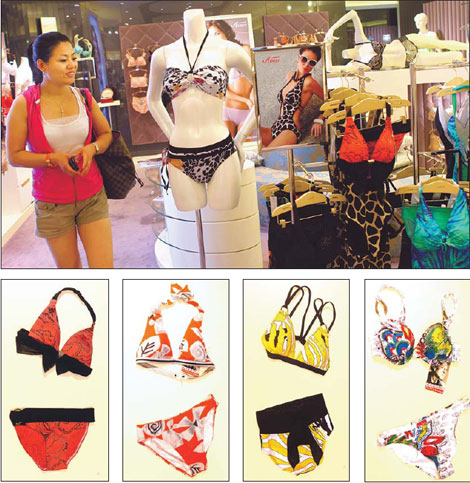
Clockwise from top: A shopper smiles at a bikini store; white bikini with artistic print, Oberon, 3,300 yuan; yellow and black bikini with thick waistband, Aimer, 1,300 yuan; orange bikini with white pattern, Oberon,
3,300 yuan; black and orange bikini, Aimer, 1,180 yuan.
With the lunar calendar now officially pointing to autumn, the temperature in Beijing is definitely on its way down.
But while the sun might be setting, city dwellers are still keen to strip off and make the most of what is on offer - both in the sky and under their clothes. That's right, it's not time to put the bikini away yet.
As the idea of "openness" becomes more literal by the day, today's woman grows more demanding of those tiny slices of swimwear - bikinis must not only shape bodies but also make them as fabulous as possible to stand out from the beach crowds.
Yvonne Ng, spa manager of a five-star hotel in Beijing, is a massive fan of swimming and says she takes a dip four to five times a week. As a result, bikinis are a focal point of her summer wardrobe and Ng has bought three this year already.
"Bikini styles for this season in Beijing are very bright and colorful," said Malaysian Ng, who added that despite the trend, her favorite piece is still a black number with a solitary pink flower on the breast.
Ng sometimes prefers swimming suits with enough material to cover her thighs, an area she tries hard not to expose, and those with cords that can be tied behind the neck and across the back - they not only make her feel safer but also help to shape her breasts.
"I have nice breasts," she said proudly.
Chen Qimei, editor of a weekly magazine about blogging, said she only wears bikinis when on the beach. With a naturally slim figure, she prefers swimsuits that have pop art or geometric patterns rather than those with pure colors.
"While quite a lot of Chinese women prefer safe swimsuits with vest-style tops and boxer short bottoms, I am really in favor of bikinis," she said. "I'm comfortable with exposing any part of my body, outside of the bikini area."
Q+A | Wang Yang
Finding a little number that can accentuate your assets can be tricky, especially since few people want to try them on in the shop. Worry not though because METRO talked to Wang Yang, a designer with Aimer Lingerie, who has a few tips to help you pick out the right swimsuit for you.
Q: What are the highlights of this season's swimwear selection?
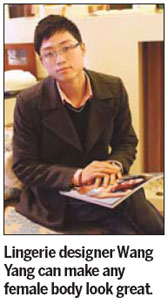 A: Exotic patterns, such as tropical flowers, have been widely used this season - bright colors are very popular while patterns are less common.
A: Exotic patterns, such as tropical flowers, have been widely used this season - bright colors are very popular while patterns are less common.
Q: How should women of differing sizes pick out the right article for them?
A: For women who are slim, I suggest them not to choose those with single colors as they can make you look even thinner. Flowery patterns can help make you appear more voluptuous.
Women who have some extra weight can disguise it with one-piece costumes and skirted swimsuits.
Q: A common problem for women is how to look sexy in a bikini. Any advice?
A: Don't worry. If you are a little flat, there are plenty of swimsuits in the market that allow you to put chest pads in.
Of course, if you are a bigger girl, you can also control your look with tops that help to hide some flesh from the eye in a pleasing way.
Bikinis can't work miracles though. If you want to cover your chubby belly, make sure to select a jumper skirt style swimsuit. And if you have a sizable bottom, try pieces with gradient colors - for example, dark in the sides and light at the front and back - because they can make your posterior look more petite.
Finally, to make your legs seem long and slim, pick out a one-piece costume that is cut very high.
Q: The summer might not last forever, but can our swimming costumes?
A: Yes, if you treat them well. Always wash them by hand and never use hot water, or the suit will lose its elasticity.
The Japan Jewellery Fair (JJF) is ideally timed for stock purchasing ahead of the autumn, Christmas and New Year retail season with a wide range of new and exciting items on offer. With its large number of high quality, established jewellery companies, Japan is currently one of the most attractive places to do business.
Best timing targeted for year-end retail season!
JJF has been held by the Japan Jewellery Association since 1993. The fair doubled in size since UBM, organiser of the September Hong Kong Jewellery & Gem Fair and other leading jewellery events in Asia, became the fair organiser in 2006. JJF is a professional jewellery exhibition held in the best timing in the Japan jewellery market, which is ideally timed for stock purchasing ahead of the autumn, Christmas and New Year retail season. The best opportunity to sell into Japan’s $10 billion jewellery market at Japan’s premium jewellery exhibition.
Why Japan?
Japan was ranked 2nd in the international comparison of GDP in 2008. Even though Japan has been slowing down in economic growth since the end of the bubble economy, its GDP still stay strong as compared to other counties. The Japan market is too huge and consistent for you to ignore.
High Light of Pavilions
"Quality Design Zone"
High Quality Fine Jewellery for Selective Buyers
The Quality Design Zone is an ideal place to look for luxury jewellery pieces that are unique and of the highest quality. Find the latest collections of innovatively designed jewellery that satisfies the diversified needs of your customers!
"Premium Jewellery Salon" in the Quality Design Zone
Japan’s best jewellery design selected by Four Seasons of Jewellery
The Premium Jewellery Salon will introduce to the industry the most innovative jewellery designers selected by editors of the official media, "Four Seasons of Jewellery".
"Bridal Jewellery Zone"
The latest collection of bridal jewellery
The Bridal Jewellery Zone with "Bridal Jewellery Showcase" will present a sparkling array of the latest bridal jewellery designs from leading suppliers in Japan. The jewellery introduced in the pavilion will be appeared at the Bridal Jewellery Fashion Show under an ideal collaboration with "ACQUA GRANZIE", the leading wedding dress brand in the world!
The "Bridal Jewellery Showcase"
The latest bridal jewellery collections form the exhibitors outside the pavilion will be a part of the Bridal Jewellery Zone!
"Designers & Craftsmen Pavilion"
The key word in designed theme is "Originality"
Looking for originalities that distinguish you from other shops? If so, the designers & Craftsmen Pavilion will be the best place to find what you are looking for!
"Japan Pearl Pavilion"
Meet Japanese companies in the pavilion that you will never meet at any other trade show outside Japan. Pearls have been attracting people of all ages and boasts overwhelming popularity in the world. You can enjoy a wide range of items with his quality but competitive prices, such as loose pearls with various types and sizes and the latest pearl jewellery collection.
"Fashion/ Silver Jewellery & Accessories Pavilion"
A collection of casual jewellery for everyday use
Fashion jewellery, silver Jewellery, and accessories linking to the latest fashion trend are popular in the Japan market nowadays. This pavilion will provide you with a great opportunity to meet new suppliers that offer you most fashionable jewellery items!
"Diamond Pavilion"
A wide range of diamond and diamond jewellery offered by Japanese players!
In recent years many international buyers have commented that they were impressed by the competitive prices that Japanese diamond dealers offered them. The Diamond Pavilion assists you to find high quality loose diamond and high-end diamond jewellery with very competitive prices!
"M.E.P.R. Pavilion- Machinery & Equipment, Packaging & Related Service"
Technologies and services to make you competitive in the market!
The exhibitors in this pavilion provide you with technologies and services focusing on the jewellery industry which make you more competitive in the market!
"Mineral Pavilion"
Uncover the mystery of stones in the Mineral Pavilion!
This year we are launching an exciting new pavilion at JJF - the Mineral Pavilion.
It is virtually impossible for the human mind to comprehend the thousands and thousands of years that it takes for a piece of natural stone to be created. But the results can be readily enjoyed by our eyes when we gaze at beautiful, mysterious and fascinating mineral stones, fossils, meteorites and other rare items.
Other International Pavilion and Association's group
[Theme Pavilion]
Quality Design Zone(Premium Jewellery Salon), Next-Generation Design Zone, DM System & Service Zone, Store Design/Sales promotion Zone
[Group Pavilion]
Atelier Group Yamanami, ICA Pavillion, INDIAN JEWELLERS ASSOCIATION of JAPAN, Japan Jewelers Association Group Pavilion, Japan Pearl Export And Processing Co-Operative Association, JEWELERS CLUB CERES, Jewellery Town OKACHIMACHI Pavilion, Joint Exhibition by Groups of Jewelry Manufacturers, KOFU NO KENMAYA, Project F, TERZETTO, Tokyo Gem Dealers, ZHO Pavilion
[National Pavilion]
German Pavilion, Hong Kong Pavilion, Italy Pavilion, Taiwan Pavilion, Thai Pavilion
Special Events
A wide variety of industry events will be held alongside the Japan Jewellery Fair exhibition. These include the prize giving ceremony for the Japan Jewellery Association's prestigious Jewellery Design Awards and the official announcement of the details of the JJA's Jewellery Day retailer campaign. A full schedule of fashion shows and stage events celebrates the beauty of exquisite jewellery, while the serious business is discussed in the seminar program that features top speakers from the domestic and international jewellery community.
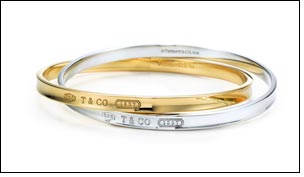 One of Tiffany’s most well known and acclaimed historic collections, the ‘1837 Interlocking Circles’ collection presents chic 18k yellow gold, rose gold and sterling silver necklaces, pendants, cuff bracelets, bangles, earrings and rings.
Exuding vintage charm, this collection by the world renowned American style icon celebrates the famous year of its founding with jewels designed for boardroom elegance as well as evening glam.
One of Tiffany’s most well known and acclaimed historic collections, the ‘1837 Interlocking Circles’ collection presents chic 18k yellow gold, rose gold and sterling silver necklaces, pendants, cuff bracelets, bangles, earrings and rings.
Exuding vintage charm, this collection by the world renowned American style icon celebrates the famous year of its founding with jewels designed for boardroom elegance as well as evening glam.
Pegah Goldooz, General Manager of Tiffany & Co., in the UAE, said: “Tiffany’s ‘1837 Interlocking Circles’ collection bears its 19th century hallmarks, blending sleek lines and concave curves. This interesting contrast of design elements offers a highly contemporary range of jewels that stand out for their exclusivity. The famed jeweller’s designs embody vision and sophistication, presenting iconic collections that are much sought after by style setters worldwide for their stunning originality and enduring beauty.”
In this historically relevant collection, one can find several timeless Tiffany favourites such as its Interlocking Circles bangle combining slim bands of sterling silver with the blushing tones of 18 rose gold, a pendant chain with two interlocking rings of sterling silver and 18k yellow gold strung on a delicate 16” chain matched by narrow sterling silver hoop earrings and the Tiffany 1837 bead bracelet dangling a mini lock charm. Its 18” long, graceful lariat is fashioned in 18k yellow gold and features three interlocking circles presenting a jewel of nonchalant glamour.
For those seeking bolder options the style icon presents the Tiffany 1837 toggle bracelet and the 1837 toggle necklace and its stunning 18k yellow gold cuff which is also available in sterling silver.
From delicate to bolder pieces, the Tiffany 1837 Interlocking Circles collection sees the legendary design house masterfully blend the classic with chic to offer a stylish range of options for discerning jewellery lovers.
Discover the vintage charm of Tiffany’s ‘1837 Interlocking Circles’ collection now available at all Tiffany & Co boutiques in Dubai and Abu Dhabi.

Designer Marc Jacobs speaks during a news conference announcing the expanded Fashion's Night Out in New York August 11, 2010.
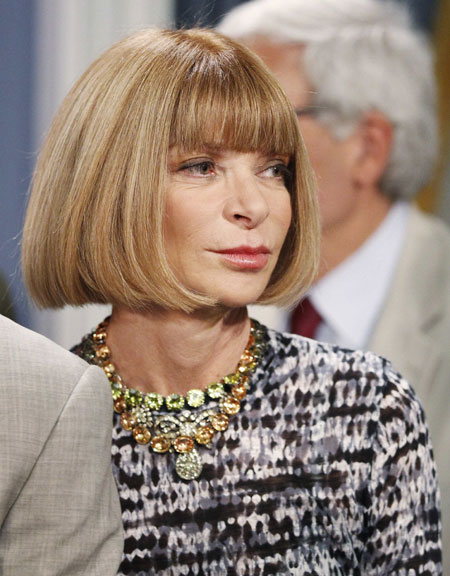
American Vogue editor Anna Wintour attends a news conference announcing the expanded Fashion's Night Out in New York August 11, 2010.
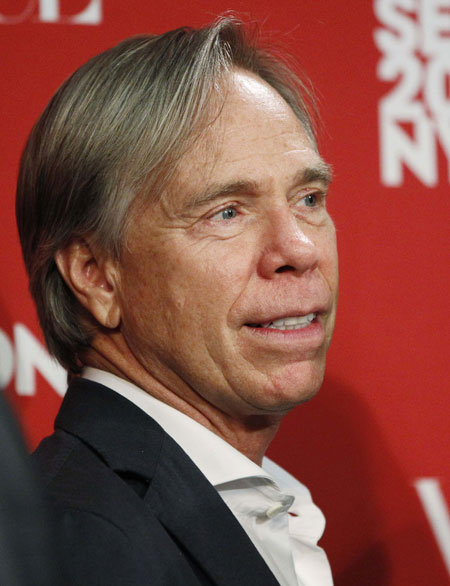
Designer Tommy Hilfiger attends a news conference announcing the expanded Fashion's Night Out in New York August 11, 2010.
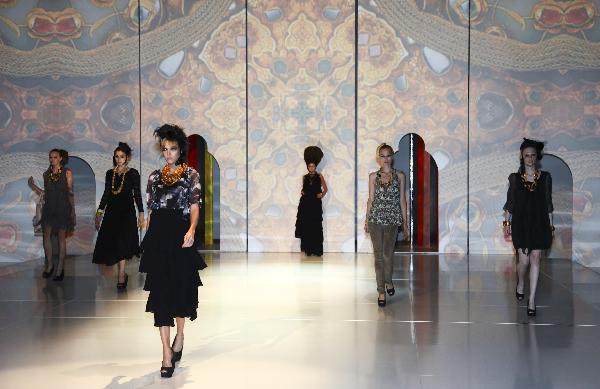
Copenhagen Fashion Week kicked off here Wednesday, with a fabulous opening show featuring "tiny pleasures" by Scandinavian designers for the 2011 spring and summer.
The fashion and color trends of the 2011 spring and summer collections, unveiled at the Fashion Week by designers from Danish and other Scandinavian countries, are all about "sharing" and "tiny pleasures," the fair's organizers said.
The show conveys the message that young adults in modern society seek to "construct a tender refuge to escape from the vagaries of the world," the organizers said.
This time, green, blue and verdigris are the favorite colors as trend setters view them as representing freshness, natural flair, and subtle harmony as well as a means to downplay the effects of the global financial crisis.
The 2011 fashion trends also place emphasis on classical elegance. Navy, black and anthracite as well as cross-cultural colors influenced by traditions of Asian countries like Japan, India, Jordan, Yemen and Turkey, reinterpret dressy essentials in a sophisticated yet carefree style.
The climax of the five-day fashion week will feature "The World's Greatest Catwalk" on Saturday on Copenhagen's downtown pedestrian street, Stroeget.
The street will be transformed into a long runway on which 220 models will walk about 1 mile (1.609 km) to beat the world record for the longest catwalk ever.
Helena Christensen, Denmark's very own supermodel, will be opening the catwalk in front of an expected crowd of 100,000 spectators.
Copenhagen Fashion Week, which was launched in 1964, now has become the largest fashion event in northern Europe, and takes place twice a year in February and August.
The organizers expect that 50,000 buyers, designers and global press representatives will attend the fashion week this year.
Victoria's Secret models Candice Swanepoel (L), Chanel Iman (C) and Erin Heatherton presented the new "Incredible by Victoria's Secret" lingerie range in New York August 10.
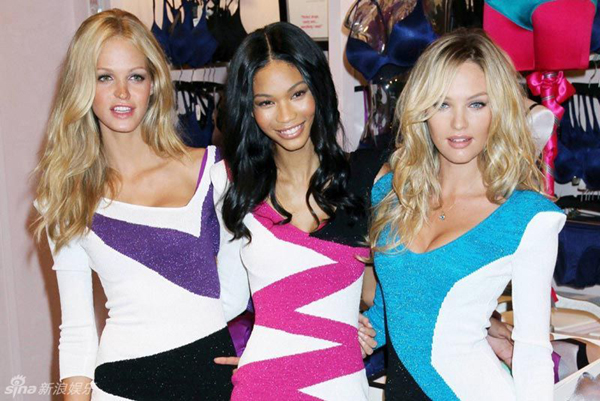
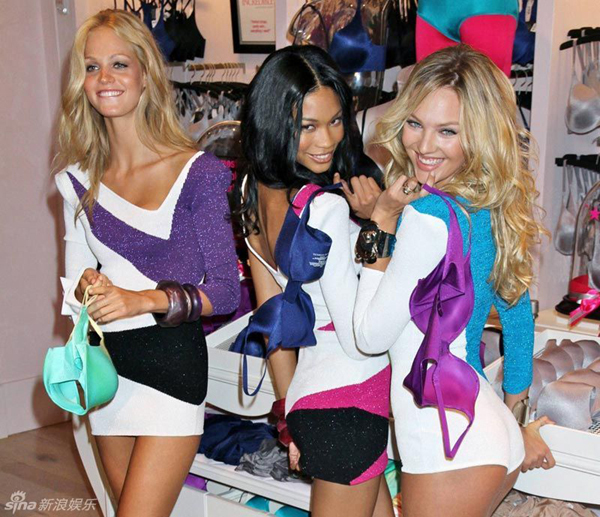
China will auction 600,000 metric tons of cotton from state reserves from Aug. 10 to satisfy demand and stabilize the market, the China Cotton Association said today.
China will sell the cotton at a minimum of 16,500 yuan ($2,439) a ton in a series of auctions, the statement posted on the state-backed group's website said. Textile companies will only be permitted to purchase maximum volumes equivalent to 10 days usage every week to avoid speculation, it said.
Cotton output fell 14.9 percent to 6.38 million tons in 2009, according to the National Statistics Bureau. Cotton in Zhengzhou reached a record in May of 18,350 yuan a ton as supplies tightened on increased demand for yarn and output cuts. Prices have fallen 9 percent since then on speculation the government would auction state reserves.
The sales should be enough to sustain China through to the new-crop season, Dong Shuzhi, analyst at Jinshi Futures Co., said by phone from Shanghai. The news will not affect prices much now because the market has been expecting it and prices have reflected the additional sales.
Cotton for January delivery, the most-actively-traded contract on the Zhengzhou Commodity Exchange, closed little changed at 16,730 yuan a ton.
Speculation Ban
Total purchases by one buyer over the course of the auctions cannot exceed its needs for one month, the group's statement said.
Buyers must only buy to meet their own production needs and are prohibited from selling the cotton to other companies, the statement said. Violators will be fined 1,000 yuan a ton and banned from participating in future cotton stockpiles sales for the next three years, it added.
All eyes are on the weather now to gauge price movements going forward, Dong said. China may produce 7.2 million tons of cotton in 2010-2011, up 1.5 percent compared with a year earlier, the U.S. Department of Agriculture said in its July report. The country may still need to import 2.5 million tons of cotton in the year ending July, 2011, the USDA said.
Output may drop by 5 percent to 10 percent because of reduced planting and adverse weather, Li Qiang, managing director at Shanghai JC Intelligence Co., said last week. Output in the U.S., the world??s largest exporter, may rise by 50 percent to close to 4 million tons, the USDA said.
People are also watching if India and Pakistan, the world's second- and fourth-largest producers, will be able to deliver their estimated output, Dong said.
Pakistan's deadliest floods in decades destroyed 30 percent of the cotton crop, Khursheed Ahmed Khan Kanjo, president of the Kissan Board of Pakistan said today. The government's target of 14 million bales of cotton won't be met and Pakistan may need to import more of the fiber this year, he said.
Output in India and Pakistan is forecast to rise 6.4 percent and 6.3 percent to 5.4 and 2.2 million tons, respectively, according to the USDA.
The construction for pilot project of cowhide wet processing and reclaimed water application technology is under way in Haining, experiements have been conducted in three tanneries in Haining city.
The technology for cowhide wet processing and reclaimed water reuse is listed as a vital scientific and technological project in Zhejiang province by provincial Science and Technology Department. The pilot projects to have a daily production capacity of 500 pieces of cowhide.
The figure is expected to grow further to $14.6 billion in the next five years, making it the world's top luxury market.
"Many of them gained experience after more than a decade of operation in the mainland, and are ready to roll over to the next phase of development of operating on their own, so they can reduce the distribution cost and raise the operating margin," said William Lo, an analyst at Ample Finance.
According to Zhangjiagang Administration of Inspection and Quarantine, the cotton import in this port were 103 batches, or 5.1 tons, with value as 92.315 million USD, up 145.2%, 264.3% and 344.3% respectively, year over year. The month import made a record high in history.
The industry observer said that there were three major reasons for this record-high import: 1. under the impact of World Expo in Shanghai, the imported cotton from Shanghai port turned to arrive in Zhangjiagang Bonded Zone for storage; 2. foreign traders sold voluminous bonded cotton eariler this month at the the price peak before the new cotton entering the markets; Huafang Group, the second largest cotton textile manufacturer in China also received its big order imported cotton this month; 3. the good import cotton trade environment in this bonded zone attracted trader in home and abroad to do business here.
Profit turned positive
According to data collected from 11,773 statistics-worthy Chinese cotton textile enterprises surveyed by National Bureau of Statistics of China, from January to May 2010, main business income of the industry increased by 29.2 per cent to 447.13 billion yuan; total profits jumped 75 per cent to 20.66 billion yuan; goods delivered surged 29.2 per cent to 36.04 billion yuan.
During Jan.-May period, enterprises in the cotton textile sector saw their ratio of profit growth edged up by 4.62% year on year, 0.2% higher than the average level of the whole textile industry. The growth was attributed to an increase in domestic sales and market confidence.
The production efficiency and management of Chinese cotton textile sector were quietly undergoing a welcome change. These, along with higher sales volumes of products, led to improvement in the operating profit margins of most large mills.
Materials price went up constantly
Cotton: The cotton production of China in 2009/10 marketing year is 7 million tons, and cotton quotas delivered was 3.6 million tons till now. It is estimated that mill use in the 2009/10 marketing year is 11 million tons.
Domestic cotton price has been going up in the first half of 2010. In July, China Cotton Index for 329-grade cotton reached at 18,500 yuan/ton. Accordingly, more and more cotton mills are begging the government to sell state reserve cotton by auction, as well as to give them import quotas for cotton as soon as possible. Moreover, the simultaneously skyrocketing prices of cotton yarn have also forced lots of cotton weaving mills to come to the end of their tether.
Production in the U.S. may rebound this harvest to around 19 million bales from 12 million last year. Output is forecast at 18.3 million bales by the USDA. Output in Brazil, the largest southern hemisphere shipper, had ??come back slightly?? from earlier expectations to around 1.1 million metric tons.
The daily world cotton indicator price in June 2010 was US95.7 cents a pound, the year-to-date high. The cotton indicator price is forecast to begin easing over the next few months as a result of a large increase in cotton production in northern hemisphere countries, particularly the United States. This expectation is reflected in the prices for the no.2 cotton futures contraction the Intercontinental Exchange where, at 15 June 2010, the July 2010 contract closed at US82 cents a pound, while the October 2010 contract closed at US79.3 cents a pound. The world indicator price for cotton (the Cotlook 'A' index) is forecast to average US82.5 cents a pound in 2010-11 (August to July), which is a 6 per cent increase from 2009-10. This forecast reflects an expected further fall in the cotton stocks-to-use ratio, despite a rebound in world cotton production in 2010-11.
Yarn: According to the National Bureau of Statistics (NBS), China yarn production was 2.16 million tons in March, up 535,000 tons or 33 percent from February. As of the end of March, the cumulative cotton yarn production of this marketing year reached 14.61 million tons, up 18 percent from year ago. In addition, according to China Customs, China exported 54,955 tons of cotton yarn, almost as twice as much of February. As of the end of March, the cumulative cotton yarn export of this marketing year reached 307,766 tons, up 31 percent from year ago.
Yarn price was running smoothly in Jan.-Feb. and then went up as stocks-to-use ratio declining in May-Jun. In Jul., Yarn price began easing as orders declining.
Grey Fabric: Grey Fabric price was running smoothly in Jan.-Feb. and then experienced high jumps in March. In Apr., price was running smoothly again and went up since May.
The China cotton market still looks bullish, though a number of uncertainties linger on. Tight supply from cotton imports, fast growth of cotton yarn exports, and the delayed cotton planting will support cotton price. However, the uncertainties of RMB appreciation, macroeconomic policy to prevent inflation, and the acceleration of the cotton shipping from Xinjiang to inland area should be noted.
Stable in 2nd half
To conclude, there is a long list of issues to keep an eye over the coming.
An unrelenting rise in the cost of raw materials and yuan appreciation could may pull down the performance of Chinese cotton textile industry in the second half of 2010 although substantial progress has been achieved by the industry in all areas of statistics in the beginning of 2010.
For the United States and the Euro area?? economy, most economists are quick to point out the uncertainties. Specifically, they refer to the fragile nature of the recovery. Although we??ve seen some improvement in consumer attitudes, their confidence in the economy is still well below where it was in 2007. One of the reasons behind that lack of confidence is the European debt crisis.
Finally, for the second half of 2010, Chinese cotton textile industry will see a continue recovery but risks still exist.